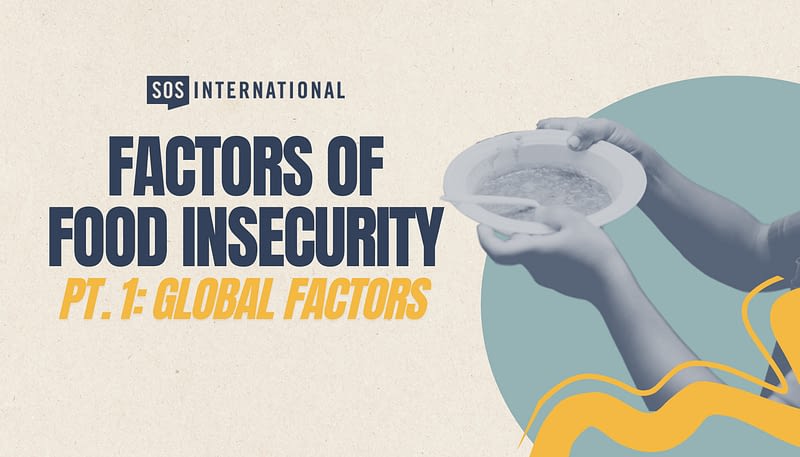Written by: SOS International
Food insecurity is a complex issue that touches every corner of the globe and manifests uniquely from one region to another. Although different countries, cities, and villages may face unique food challenges, global factors loom over them all. As we examine some of the most common overarching factors contributing to this escalating crisis, we must recognize that these elements are just the tip of the iceberg. They reveal a deeply interconnected web of causes that demand our attention and action. In part one of this pair of blogs, we will briefly examine the major global factors contributing to food insecurity.
Distinguishing between global and more local factors helps clarify what makes food insecurity tricky. Global factors such as population growth, the environment, weather, and conflict/ political instability impact entire countries or regions. While these factors play out on a grand scale, how they affect people in local communities will vary.
Population Growth
The rapid growth of our global population may seem like the most obvious challenge of the food insecurity problem. From 2010 to 2022, the global population grew by 1 billion people, increasing the population by 10% in just 12 years.¹ Today, we have well over 8 billion people on the planet, and the growth continues steadily. Population growth directly affects food demand, as more people require more food.
Population growth can be particularly challenging when concentrated in areas where food insecurity exists. Think about any city that you have seen grow in population in the last decade: if you googled food insecurity rates in that city, you would likely find that those rates have increased. While a city’s population growth impacts its food supply and demand, it also impacts basic needs, such as housing. This is another component in food insecurity, as increased demand for housing increases prices, disproportionately impacting impoverished people who typically can’t keep up with price increases. This adds to the costs that those in poverty must juggle: housing, food, bills, transportation, medical expenses, etc.
Population growth is a factor that doesn’t need solving, as everyone has the right to basic needs. Still, the reality is that the population is a major player in global food insecurity numbers.
Environment, Extreme Weather and Natural Disasters
Our environment profoundly affects the food we grow and eat. The diverse climates of our world each present unique weather challenges, shaping not just how we cultivate crops but also how food reaches our tables. Devastating heatwaves, relentless droughts, or catastrophic floods can wreak havoc on harvests of major crops that depend on ideal temperatures and moisture.
On any given day, extreme weather events, such as wildfires devouring green fields and heavy rains drowning out crops, threaten the delicate balance of our food supply chain. While many regions have developed innovative strategies to combat these obstacles, these solutions often fall short for the masses or provide limited relief.
The result of the weather creates two issues. First, decreased production of crops results in an agricultural system that cannot keep up with demand, leading to increased prices. Second, the reduced availability of these vital, healthy crops and increased prices lead people to consider cheaper foods that are easier to obtain. These are often foods that lack nutritional value, and those who grow to rely on these foods may face health risks down the line, furthering another aspect of food insecurity.
Political instability and conflict
Political instability and conflict significantly impact food security by disrupting food systems’ availability, access, and stability. Turmoil and war disrupt supply chains and trade routes, leading to food shortages, especially in import-reliant regions. According to a recent Oxfam report, 278 million people in the countries in the 54 conflicts face crisis-level food insecurity.²
Economic instability can cause inflation and currency devaluation, increasing food prices and limiting access for low-income populations—agricultural unrest can lead to reduced crop yields.
Further, conflict often displaces individuals, forcing them to abandon farming and rely on food aid. Government corruption can divert essential funds, hindering support for sustainable food systems. Sudden policy changes and reliance on international assistance further exacerbate the vulnerability of food systems. Political instability creates a precarious environment, leading to shortages and increased food insecurity.
These are some of the major players in food security. They are unpredictable and seemingly unstoppable factors that impact millions’ access and availability of food each year. As you likely noticed, these factors make food more expensive and more difficult to access. These factors inevitably impact everyone but disproportionately affect one group with a specific vulnerability.
1.United Nations. (n.d.). Global Issues: Population. United Nations. https://www.un.org/en/global-issues/population
2.Cohen, M., & Messer, E. (2024, October 15). Food Wars: Conflict, Hunger, and Globalization. Oxfam.org.https://oxfamilibrary.openrepository.com/bitstream/handle/10546/621657/bp-food-wars-241016-en.pdf







